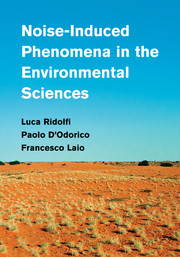Book contents
- Frontmatter
- Contents
- Preface
- 1 Introduction
- 2 Noise-driven dynamical systems
- 3 Noise-induced phenomena in zero-dimensional systems
- 4 Noise-induced phenomena in environmental systems
- 5 Noise-induced pattern formation
- 6 Noise-induced patterns in environmental systems
- Appendix A Power spectrum and correlation
- Appendix B Deterministic mechanisms of pattern formation
- Appendix C List of symbols and acronyms
- Bibliography
- Index
Appendix B - Deterministic mechanisms of pattern formation
Published online by Cambridge University Press: 05 August 2011
- Frontmatter
- Contents
- Preface
- 1 Introduction
- 2 Noise-driven dynamical systems
- 3 Noise-induced phenomena in zero-dimensional systems
- 4 Noise-induced phenomena in environmental systems
- 5 Noise-induced pattern formation
- 6 Noise-induced patterns in environmental systems
- Appendix A Power spectrum and correlation
- Appendix B Deterministic mechanisms of pattern formation
- Appendix C List of symbols and acronyms
- Bibliography
- Index
Summary
Introduction
In this appendix we provide a mathematical description of the three major deterministic models of self-organized pattern formation that are commonly invoked to explain mechanisms of spatial self-organization in the biogeosciences. In these models patterns emerge from a mechanism of symmetry-breaking instability, whereby the uniform state of the system becomes unstable, thereby leading to the emergence of spatial patterns. Spatial interactions induce this instability, whereas the resulting patterns are stabilized by suitable nonlinear terms. In Turing and kernel-based models, symmetry breaking is the result of the interactions between short-range activation and long-range inhibition, i.e., of positive and negative feedbacks acting at different spatial scales. In the third class of models (i.e., differential-flow models) symmetry breaking emerges as a result of the differential-flow rate between two (or more) species.
In Turing and differential-flow models, the nonlinearities are local (i.e., they do not appear in the terms expressing spatial interactions), whereas in kernel-based models the nonlinearities can be in general nonlocal, i.e., they can appear as multiplicative functions of the term accounting for spatial interactions (e.g., Lefever and Lejeune, 1997). In a particular class of kernel-based models – known as neural models (e.g., Murray and Maini, 1989) – the nonlinearities are only local and do not affect the spatial interactions. In these models the nonlinear terms appear as additive functions of the spatial interaction term.
- Type
- Chapter
- Information
- Noise-Induced Phenomena in the Environmental Sciences , pp. 274 - 288Publisher: Cambridge University PressPrint publication year: 2011

